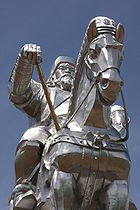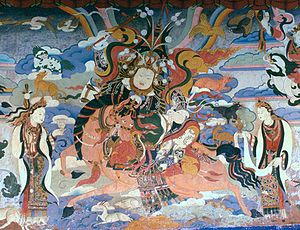
Uliger
Encyclopedia

Mongols
Mongols ) are a Central-East Asian ethnic group that lives mainly in the countries of Mongolia, China, and Russia. In China, ethnic Mongols can be found mainly in the central north region of China such as Inner Mongolia...
and Buryats
Buryats
The Buryats or Buriyads , numbering approximately 436,000, are the largest ethnic minority group in Siberia and are mainly concentrated in their homeland, the Buryat Republic, a federal subject of Russia...
of north-east Asia
Asia
Asia is the world's largest and most populous continent, located primarily in the eastern and northern hemispheres. It covers 8.7% of the Earth's total surface area and with approximately 3.879 billion people, it hosts 60% of the world's current human population...
. They are an important part of the oral traditions among the Buryats and other Siberian tribes, and among other functions, were used to orally transmit Buddhist birth stories. The tales are significant in Mongolian literature, given its long standing tradition of passing stories on by word of mouth.
Format
Traditionally, üligers are delivered orally in alliterative verseAlliterative verse
In prosody, alliterative verse is a form of verse that uses alliteration as the principal structuring device to unify lines of poetry, as opposed to other devices such as rhyme. The most commonly studied traditions of alliterative verse are those found in the oldest literature of many Germanic...
s, often taking the form of couplet
Couplet
A couplet is a pair of lines of meter in poetry. It usually consists of two lines that rhyme and have the same meter.While traditionally couplets rhyme, not all do. A poem may use white space to mark out couplets if they do not rhyme. Couplets with a meter of iambic pentameter are called heroic...
s or quatrain
Quatrain
A quatrain is a stanza, or a complete poem, consisting of four lines of verse. Existing in various forms, the quatrain appears in poems from the poetic traditions of various ancient civilizations including Ancient Greece, Ancient Rome, and China; and, continues into the 21st century, where it is...
s. Like other epics
EPICS
The Experimental Physics and Industrial Control System is a software environment used to develop and implement distributed control systems to operate devices such as particle accelerators, telescopes and other large experiments. EPICS also provides SCADA capabilities...
in oral literature
Oral literature
Oral literature corresponds in the sphere of the spoken word to literature as literature operates in the domain of the written word. It thus forms a generally more fundamental component of culture, but operates in many ways as one might expect literature to do...
, individual üliger can vary greatly in length and content from one occasion to the next. One famous performer, the Inner Mongolia
Inner Mongolia
Inner Mongolia is an autonomous region of the People's Republic of China, located in the northern region of the country. Inner Mongolia shares an international border with the countries of Mongolia and the Russian Federation...
n Muu-ōkin, "was said to be able to recite üliger that lasted for months." Like other epic poets, üliger performers accompanied themselves with an instrument, in this case a four-stringed fiddle.
Subject matter
Üligers generally tell the legends of mythological and historical heroes. Common as the villain in the üliger is a monster with several heads, known as the "manggus," whom the hero consistently defeats. The setting for the telling of these tales was usually around the fire in the winter. Under usual circumstances üliger are only told in the wintertime; reciting them in the summer may cause winter weather to return.Popular üligers include the proverbs attributed to Genghis Khan
Genghis Khan
Genghis Khan , born Temujin and occasionally known by his temple name Taizu , was the founder and Great Khan of the Mongol Empire, which became the largest contiguous empire in history after his death....
, and the epics surrounding Khan's life, including the tale about his two white horses. Still recited today by Mongolian singers are üligers based on the story of Hua Guan Suo, one of the warriors from the Romance of the Three Kingdoms
Romance of the Three Kingdoms
Romance of the Three Kingdoms, written by Luo Guanzhong in the 14th century, is a Chinese historical novel based on the events in the turbulent years near the end of the Han Dynasty and the Three Kingdoms era of Chinese history, starting in 169 and ending with the reunification of the land in...
. Longer myths, such as the Epic of King Gesar, were important vehicles for the transmission of shamanic traditions. Oirad epics relayed in üligers are Jangar, the history of the four Oirad's Victory over the Mongols, Khan Kharangui, Bum Erdene, etc.

Woodblock printing
Woodblock printing is a technique for printing text, images or patterns used widely throughout East Asia and originating in China in antiquity as a method of printing on textiles and later paper....
of the story was compiled by a scholarly monk from Lingtsang. Üligers of King Gesar have even been told as far west as the Caspian Sea
Caspian Sea
The Caspian Sea is the largest enclosed body of water on Earth by area, variously classed as the world's largest lake or a full-fledged sea. The sea has a surface area of and a volume of...
, reaching Europe
Europe
Europe is, by convention, one of the world's seven continents. Comprising the westernmost peninsula of Eurasia, Europe is generally 'divided' from Asia to its east by the watershed divides of the Ural and Caucasus Mountains, the Ural River, the Caspian and Black Seas, and the waterways connecting...
with the Tibetan Buddhist
Tibetan Buddhism
Tibetan Buddhism is the body of Buddhist religious doctrine and institutions characteristic of Tibet and certain regions of the Himalayas, including northern Nepal, Bhutan, and India . It is the state religion of Bhutan...
Kalmyk
Kalmyk people
Kalmyk people is the name given to the Oirats, western Mongols in Russia, whose descendants migrated from Dzhungaria in 1607. Today they form a majority in the autonomous Republic of Kalmykia on the western shore of the Caspian Sea. Kalmykia is Europe's only Buddhist government...
people.
Chinese and Tibetan literature also underlies the Üliger-iin Dalai (The Ocean of Parables, see also Kathāsaritsāgara
Kathāsaritsāgara
Kathasaritsagara is a famous 11th-century collection of Indian legends, fairy tales and folk tales as retold by a Saivite Brahmin named Somadeva....
), a collection of Buddhist birth stories (including the set of stories "The Wise Man and the Fool") edited in 1837 by O. Kowalewski
Józef Kowalewski
Józef Kowalewski was a Polish orientalist. Founder of the Philomatic Association, in 1824 convicted by the Russian authorities for pro-independence Polish activity and exiled into Russia. Allowed to study at the Kazan University, he studied Mongolia, particularly Mongolian language and Tibetan...
. There is some scholarly debate as to whether a Chinese or a Tibetan version of "The Wise Man and the Fool" is the direct source for the Mongolian text, but while there are small variations, on the whole the Mongolian version is quite faithful to its originals.
External links
Related bibliography
- Heissig, Walther. "Mongolen." Enzyklopädie des Märchens: Handwörterbuch zur historischen und vergleichenden Erzählforschung. Eds. Kurt Ranke and Rolf Wilhelm Brednich. Walter de Gruyter, 1999. 812-23. ISBN 9783110154535.
- Lohia, Sushama. The Mongol Tales of the 32 Wooden Men (γučin qoyar modun kümün-ü üliger). Harrassowitz, 1968.
- Popke, Suzanne L. Buryat Uliger: The Adventures of Tolei Mergen. 2005.

